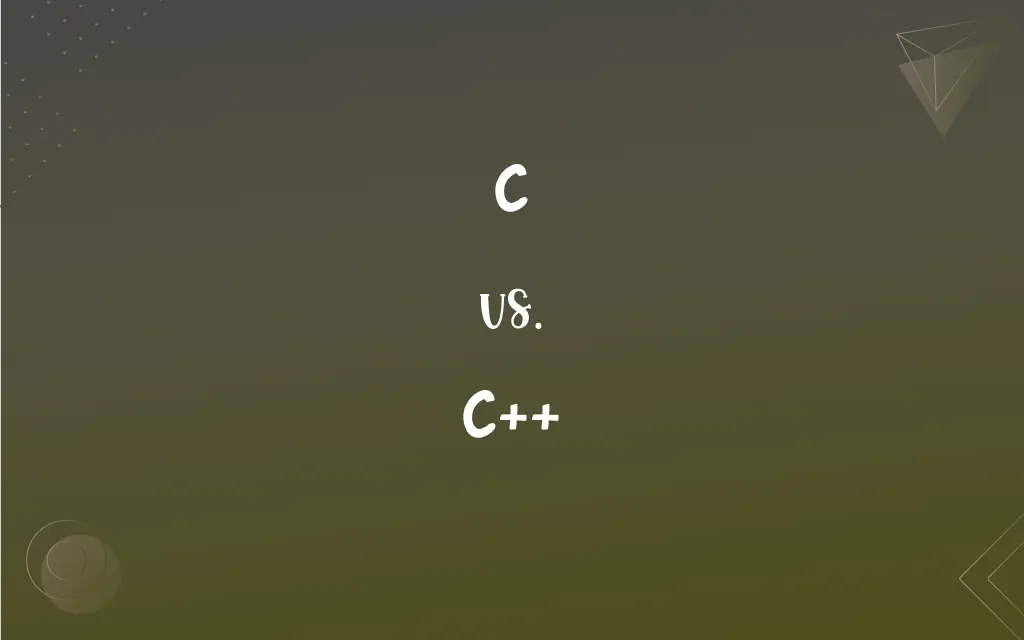C vs. C++: What's the Difference?
Edited by Janet White || By Harlon Moss || Updated on October 26, 2023
C is a procedural programming language, while C++ is both procedural and object-oriented.

Key Differences
C is a foundational programming language that was developed in the early 1970s. C++ came later, in the 1980s, as an extension to C.
While C provides a structure for procedural programming, C++ offers additional features that support object-oriented programming and generic programming.
In C, data and functions are separate. In contrast, C++ introduces the concept of classes where data and functions can be encapsulated together.
Memory management in C is done using functions like malloc() and free(). C++ provides new and delete operators for memory allocation and deallocation.
C relies heavily on libraries for operations, while C++ not only has libraries but also built-in functions and classes in its Standard Template Library (STL).
ADVERTISEMENT
Comparison Chart
Programming Paradigm
Procedural
Procedural, Object-Oriented, and Generic
Memory Management
Uses malloc() and free()
Uses new and delete along with malloc() & free()
Data Encapsulation
No built-in support
Uses classes for encapsulation
Library Support
Standard C libraries
Both Standard C and Standard Template Library (STL)
Function Overloading
Not supported
Supported
ADVERTISEMENT
C and C++ Definitions
C
C is known for its performance and efficiency.
High-performance applications often use C for critical parts.
C++
C++ has a rich Standard Template Library (STL).
The C++ STL provides ready-to-use templates for various data structures and algorithms.
C
C is a procedural programming language.
I learned C before diving into other languages.
C++
C++ is an extension of C with object-oriented features.
After mastering C, I moved on to C++ to learn about classes and objects.
C
C is the basis for many operating systems.
Unix was originally written in C.
C++
C++ introduced the concept of classes and inheritance.
In C++, you can create a class hierarchy using inheritance.
C
C was developed at Bell Labs in the 1970s.
Many modern languages, including C++, have roots in C.
C++
C++ allows for operator and function overloading.
In C++, you can have multiple functions with the same name but different parameters.
C
C programs compile to machine code.
C code runs close to the hardware level.
C++
C++ supports both procedural and object-oriented programming.
C++ offers the flexibility of using both paradigms.
C
A widely used programming language.
FAQs
Can C++ run C code?
Generally, C++ can run C code, but there are certain differences and caveats.
What is C?
C is a procedural programming language developed in the early 1970s.
Do C and C++ use the same compiler?
They can use separate compilers, but many C++ compilers can compile C code.
Is C harder to learn than C++?
C is simpler in terms of features, but C++ introduces more concepts due to its object-oriented nature.
Which is older, C or C++?
C is older, developed in the 1970s, while C++ came in the 1980s.
Is it beneficial to learn C before C++?
It can be helpful, as understanding C provides a foundation for C++ concepts.
Can C support object-oriented programming?
C is fundamentally procedural; however, object-oriented concepts can be implemented manually with structures.
Why is C++ called an "extension" of C?
Because C++ incorporates all of C's features and adds new ones, particularly for object-oriented programming.
What kind of applications are built using C?
Operating systems, embedded systems, and performance-critical applications are often written in C.
What is function overloading in C++?
It allows multiple functions with the same name but different parameters in C++.
How is C++ related to C?
C++ is an extension of C, introducing object-oriented and generic programming features.
Why is C known for its performance?
C compiles to machine code, making it run close to the hardware level.
Which is more popular today, C or C++?
Both remain popular for different applications, but C++ is more prevalent in areas like game development.
Are there object-oriented features in C?
Not natively, but programmers can emulate some object-oriented features using structures.
How does C++ handle data encapsulation?
C++ uses classes to encapsulate data and associated functions.
What is the STL in C++?
STL stands for Standard Template Library, a collection of template classes in C++.
Can C programs utilize the C++ Standard Template Library (STL)?
No, the STL is specific to C++ and requires its features for implementation.
What's a significant addition in C++ compared to C?
C++ introduced classes, enabling object-oriented programming.
Are C and C++ used in modern software development?
Yes, both languages are widely used, especially in performance-critical applications.
What's the difference in memory management between C and C++?
C uses malloc() and free(), while C++ introduces new and delete but can also use C methods.
About Author
Written by
Harlon MossHarlon is a seasoned quality moderator and accomplished content writer for Difference Wiki. An alumnus of the prestigious University of California, he earned his degree in Computer Science. Leveraging his academic background, Harlon brings a meticulous and informed perspective to his work, ensuring content accuracy and excellence.
Edited by
Janet WhiteJanet White has been an esteemed writer and blogger for Difference Wiki. Holding a Master's degree in Science and Medical Journalism from the prestigious Boston University, she has consistently demonstrated her expertise and passion for her field. When she's not immersed in her work, Janet relishes her time exercising, delving into a good book, and cherishing moments with friends and family.































































